Ecological Regions Of Malaysia

From peninsular mountains to low-lying islands and out to the sea, Malaysia is mostly covered in forests and wetlands. It lies in Southeast Asia and borders Thailand, Brunei, and Indonesia. The country also shares maritime borders with Singapore, Indonesia, and Vietnam. Malaysia is comprised of East Malaysia and Peninsular Malaysia. The state's lowest point is the South China Sea (0m) and Mt. Kinabalu, at 4,100 meters, is the highest point.
Ecological Regions Of Malaysia
Borneo Lowland Rain Forest
This terrestrial ecoregion is classified in the tropical and subtropical moist broadleaf forests biome. The ecoregion lies in the lowland regions of Borneo Island. The region’s climate is tropical, and monthly rainfall exceeds 8 inches in a given year. The ecoregion’s geology comprises of sedimentary and volcanic rocks, and limestones.
Dipterocarps are the dominant tree species, forming canopies of between 24 to 36 meters high. Other tree families include Euphorbiaceae, Lauraceae, and Annonaceae. The trees support an undergrowth of orchids, herbs, ferns, and palms. The region is home to endemic bats and rodents as well as the clouded leopard, Asian elephant, sun bear, Bornean orangutan, Bornean white-bearded gibbon, Sumatran rhinoceros, and 13 primate species. Threats to this ecoregion are logging, agricultural development, and fires. Conservation areas in the region include Tabin Wildlife Reserve and Kayan Mentarang National Park.
Borneo Montane Rain Forests
The Borneo montane rain forests are a terrestrial ecoregion classified in the tropical and subtropical moist broadleaf forests biome. The ecoregion comprises of montane forests located in the central part of Borneo Island. Precipitation recorded is more than that of the lowlands, and the region’s geology is of melange and old volcanic rocks.
The dominant trees are oaks and chestnut alongside Myrtaceae, Ericaceae, Podocarpaceae, and Fagaceae families. The canopies support more epiphytes than the lowland including lichen, orchids, and ferns. The region supports large populations of small mammals such as rats, civets, shrews, and squirrels. Larger mammals roaming the forests are macaque monkey species, orangutan, langurs, and the Sumatran rhinoceros. The location of the ecoregion renders it inaccessible and largely undisturbed. Significant parts of the region lie in the Danum Valley Conservation Area and Kayan Mentarang National Park.
Greater Sundas Mangroves
The Greater Sundas Mangroves ecoregion occupies the coastlines of Borneo, Sumatra, and Java Islands in Malaysia and Indonesia. Vegetation along the mangrove ranges from Nipa palms, Rhizophoras, Avicennia, Bruguieras, and Sonneratia. Notable fauna includes the proboscis monkey, saltwater crocodile, common redshank, Stork-billed kingfisher, and Irrawaddy dolphin. Among the threats to this ecoregion are poaching, agricultural expansion, urban development, and logging. The Bako National Park protects large tracts of the mangrove ecoregion.
Peninsular Malaysian Peat Swamp Forests
This terrestrial ecoregion is classified under the tropical and subtropical moist broadleaf forests biome. The region is located in the western and eastern parts of the Malay Peninsula. The region does not support abundant life since the peat swamps are acidic and the soils are infertile. The dominant trees are strangler firs and dipterocarps, which support an undergrowth of sealingwax palm and pandan. The region supports populations of the clouded leopard, tiger, Sumatran rhinoceros, Asian elephant, and Malayan tapir. The ecoregion is threatened by agricultural development, deforestation, fires, and mining. The area remains largely unprotected.
Other Ecological Regions of Malaysia
Marine ecoregions in Malaysia are the Andaman Sea, Sulu Sea, and Sulawesi sea. These ecoregions are threatened by pollution caused by various coastal activities and oil spills, as well as by coastal development. Other ecoregions of Malaysia are Kayah-Karen and Tenasserim Moist Forests; Kinabalu Montane Scrub; Peninsular Malaysian Lowland and Mountain Forests; Peninsular Malaysian montane rain forests; Peninsular Malaysian rain forests, and Sundaland Rivers and Swamps.
Ecological Regions Of Malaysia
| Ecological Regions of Malaysia (as per WWF) | Type |
| Andaman Sea | Marine |
| Borneo lowland rain forest | Terrestrial |
| Borneo montane rain forests | Terrestrial |
| Greater Sundas Mangroves | Terrestrial |
| Kayah-Karen and Tenasserim Moist Forests | Terrestrial |
| Kinabalu Montane Scrub | Terrestrial |
| Peninsular Malaysian Lowland and Mountain Forests | Terrestrial |
| Peninsular Malaysian montane rain forests | Terrestrial |
| Peninsular Malaysian peat swamp forests | Terrestrial |
| Peninsular Malaysian rain forests | Terrestrial |
| Sulu Sea | Marine |
| Sulawesi Sea | Marine |
| Sundaland Rivers and Swamps | Terrestrial |











